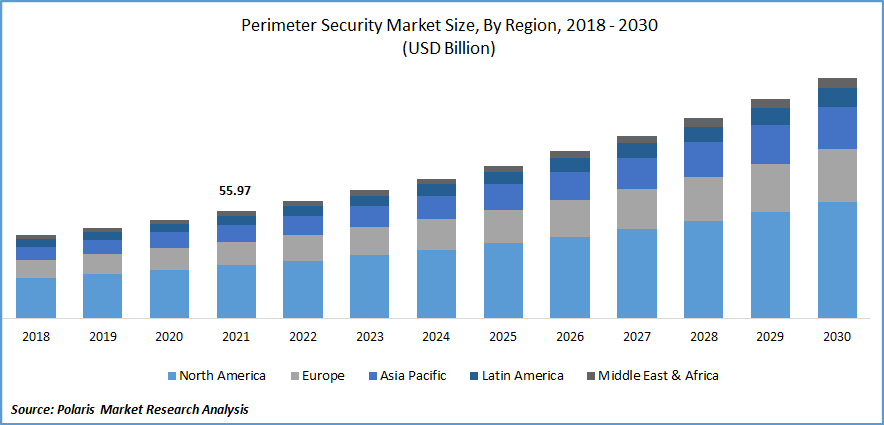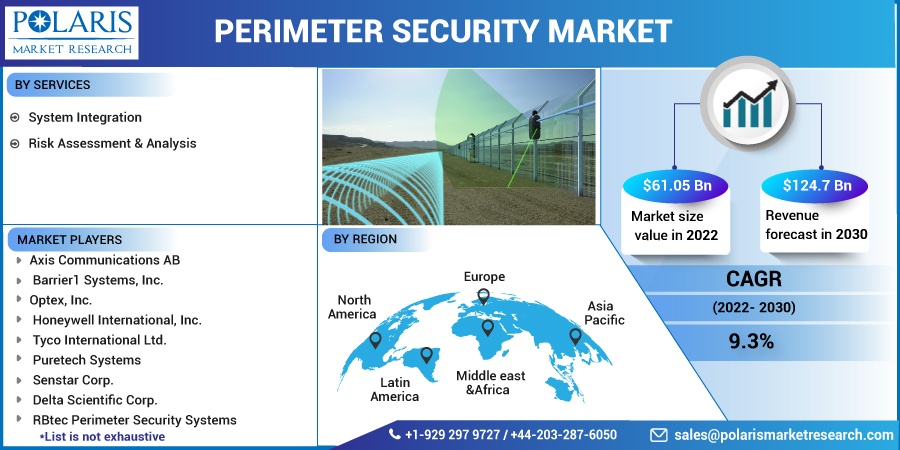
Perimeter Security Market Share, Size, Trends, Industry Analysis Report
By Services (System Integration, Risk Assessment and Analysis); By Region; Segment Forecast, 2022-2030
- Published Date:Dec-2022
- Pages: 119
- Format: PDF
- Report ID: PM2941
- Base Year: 2021
- Historical Data: 2018-2020
Report Outlook
The global perimeter security market was valued at USD 55.97 billion in 2021 and is expected to grow at a CAGR of 9.3% during the forecast period.
The necessity to increase safety and security across numerous industries is a major factor in the market's expansion. Due to substantial developments in cloud hosting and video surveillance software, the surveillance market has transformed in comparison to the previous ten years.

Know more about this report: Request for sample pages
Natural barriers or artificial fortifications that detect intrusions into a location under watch and notify the guards to respond appropriately are known as perimeter security. A perimeter security system keeps intruders out and hostages inside the guarded area to detect burglary and damage. The integrated electrical and mechanical components that makeup perimeter security systems include concertinas, tactical radars, video sensors, sensor cables, fences with sensors, and microwave and infrared barriers.
In recent years, perimeter security systems have changed as a result of technological breakthroughs. Intruders were mostly prevented and detected using these technologies at military installations, key infrastructure sites, and other high-security places. However, there is growing interest in using these systems in a number of locations, including urban and suburban regions, transit hubs, shopping malls, and more.
For instance, the Prama Hikvision, a joint venture between Prama Technologies and Hangzhou Hikvision Digital Technology that provides video surveillance and security systems, launched a production facility in Vasai, India, in 2019. The geographical reach of businesses in India and the Asia-Pacific area is anticipated to be strengthened by this aspect.
The installation of perimeter security systems in various locations, such as military bases and important infrastructure. Due to an increase in terrorism, theft, sabotage, and illegal immigration, there is a considerable increase in demand for high-tech security systems worldwide. For economies to grow, advanced perimeter security solutions are necessary. Due to the huge financial expenditures involved, terrorism has a detrimental effect on the economy. For the purpose of terrorism and safeguarding vital infrastructure, governments all over the world are concentrating on implementing perimeter security regulations and industry standards.
The COVID-19 epidemic has dramatically increased the reliance on law enforcement and homeland security organizations. Emergency services, critical infrastructure security, and other enterprises rely on perimeter security solutions to deliver vital services to their clients. The pandemic has greatly increased reliance on homeland security and law enforcement agencies, crucial infrastructure security, emergency services, and other organizations, all of which are leveraging perimeter security solutions for delivering key services to clients. Perimeter security is unquestionably crucial for infrastructure, airports, data centers, and other high-end applications, even though many people now work from home. The infrastructure for defense and security is currently being strengthened by many regional administrations.
 Know more about this report: Request for sample pages
Know more about this report: Request for sample pages
Industry Dynamics
Growth Drivers
Governments have been forced to set strict rules regarding the safety of nations due to the growing threat of terrorism and cross-border intrusions, which has led to perimeter security market expansion. The primary element influencing the market is an increase in the construction of smart infrastructure and cities. The government is increasingly in favor of installing various security systems in strategic sites. Automation-related technological developments have sped up the use of cutting-edge methods, such as video analytics and aerial drones, to produce better results.
The deployment of perimeter security systems has increased as a result of escalating criminal activity, including organized crime, theft, smuggling, and people trafficking, as well as rising citizen concerns. The development of smart cities and smart infrastructure is a result of the expansion of technology.
As a result, the use of security systems at commercial complexes, entertainment centers, and public locations is increasing. The internet and the newest mobile gadgets have been integrated with security systems to make surveillance simpler. Infrared, microwave, radar, and seismic sensors have all been made possible by modern technology.
Report Segmentation
The market is primarily segmented based on services and region.
|
By Services |
By Region |
|
|
Know more about this report: Request for sample pages
In 2021, the system integration segment dominated the market, accounting for the largest market share.
Security system vendors are increasingly focusing on system integration and consulting services, which in 2021 will account for the largest portion of global revenue. The controller's ability to make decisions and receive more accurate information is improved by the integration of multiple security systems.
Access to real-time data, efficient company operations, and streamlined & optimized functional workflow are all benefits of system integration and consulting services for enterprises. The market is progressing due to the implementation of cutting-edge technologies such as IP-based security cameras for remote access, motion sensors, and wireless technology. Over the course of the projected period, it is anticipated that the risk assessment and analysis services would expand extremely quickly. Large enterprises are using managed security services more frequently as it is simpler to outsource their whole security system, which helps them detect security gaps in the protection of sensitive data and deters burglars from breaking into their offices.
The demand in Asia-Pacific is expected to witness significant growth.
The region of Asia-Pacific is expected to experience the quickest growth due to the region's increasing infrastructure and strict governmental policies surrounding national security. The market growth is also significantly influenced by the military and defense, transportation, oil and gas, chemical, and other industries as well as important infrastructures and nuclear facilities. The demand for perimeter security systems has grown as a result of rising crime rates in the Asia Pacific area, including personal crime and data theft.
The North America region dominated the global market in 2021 due to the presence of technology hubs in the U.S. and ongoing R&D in the industry and accounted for the highest part of global revenue. Additionally, it is anticipated that the region's growing use of the Internet of Things (IoT) would support regional market expansion..
Competitive Insight
Some of the major players operating in the global market include, Axis Communications AB, Barrier1 Systems, Inc., Optex, Inc., Honeywell International, Inc., Tyco International Ltd., Puretech Systems, Senstar Corp., Delta Scientific Corp., RBtec Perimeter Security Systems, Cias Elettronica Srl
Recent Developments
- In May 2019, Hikvision purchased Pyronix, a company that specializes in intrusion alarms. With this acquisition, Hikvision will have access to a brand-new market for security products.
- In April 2020, Gemalto, a Dutch-based global provider of digital security services, was purchased by Thales. Thales Group now has a wider range of products to enable it to lead the world in digital identification and security thanks to this acquisition.
Perimeter Security Market Report Scope
|
Report Attributes |
Details |
|
Market size value in 2022 |
USD 61.05 billion |
|
Revenue forecast in 2030 |
USD 124.7 billion |
|
CAGR |
9.3% from 2022 - 2030 |
|
Base year |
2021 |
|
Historical data |
2018 - 2020 |
|
Forecast period |
2022 - 2030 |
|
Quantitative units |
Revenue in USD billion and CAGR from 2022 to 2030 |
|
Segments covered |
By Services, By Region |
|
Regional scope |
North America, Europe, Asia Pacific, Latin America; Middle East & Africa |
|
Key companies |
Axis Communications AB, Barrier1 Systems, Inc., Optex, Inc., Honeywell International, Inc., Tyco International Ltd., Puretech Systems, Senstar Corp., Delta Scientific Corp., RBtec Perimeter Security Systems, Cias Elettronica Srl |
